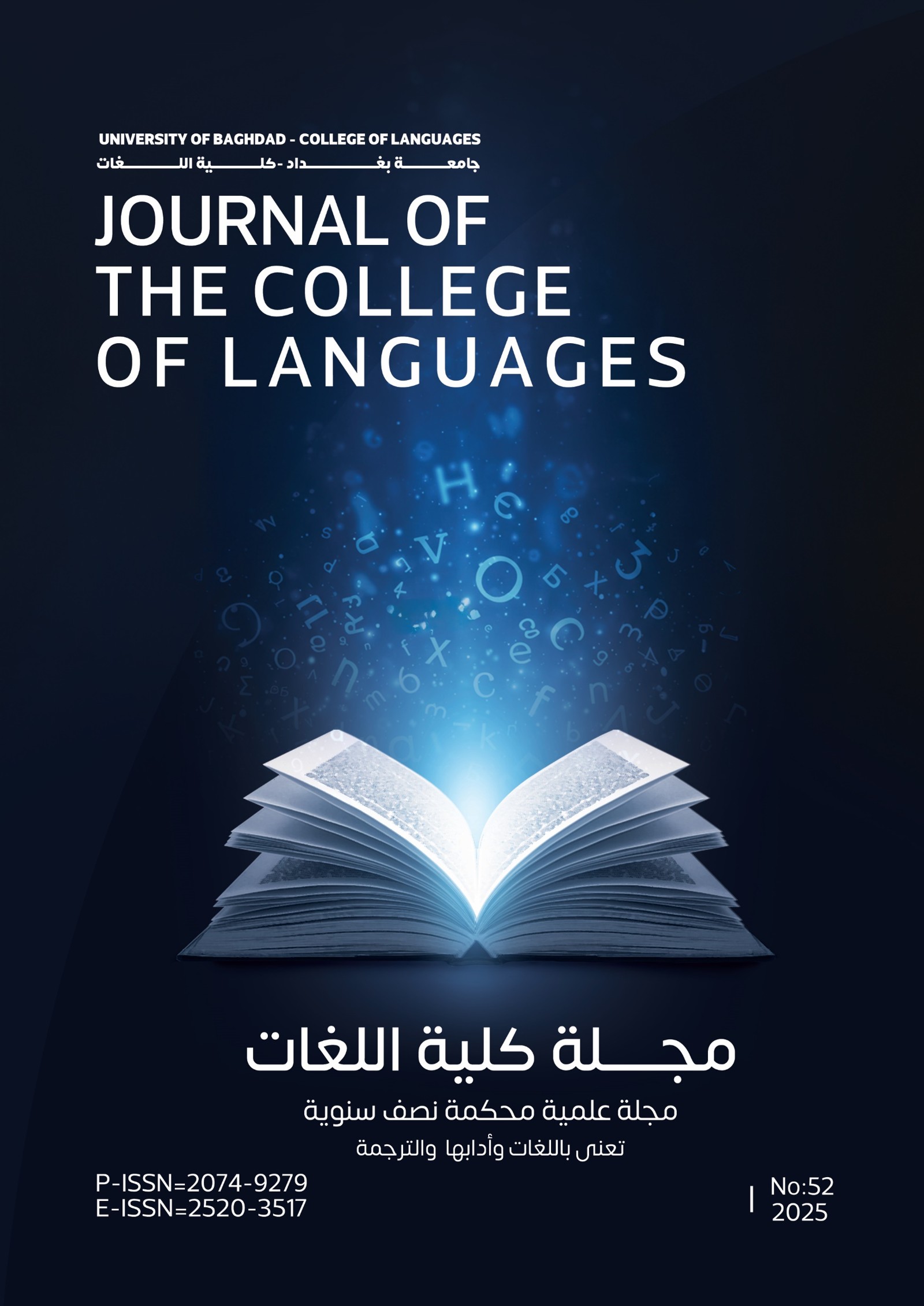A Critical Pragmatic Approach to Aggression in Moriatry's Big Little Lies
DOI:
https://doi.org/10.36586/jcl.2.2023.0.47.0126Keywords:
Aggression, critical studies, familial communicatio, pragmatic stratigiesAbstract
Abstract
People are supposed to use language harmoniously and compatibly. However, aggression may characterize much of human communication. Aggression has long been recognized as a negative anti-social issue that prevails in most personal interactions. If it abounds in familial communications, it is more dangerous due to its harmful effects on individuals, and consequently on societies. Aggression refers to all the instances in which we try to get our way without any consideration for others. Moriarty’s novel (2014), Big Little Lies, is argued to represent the patterns of aggressive communications. This study aims to find out the motivations behind aggressive language in familial communication in this best-seller novel. It aims to identify the pragmatic strategies that are utilized to convey aggression in the data under scrutiny. As aggression is a critical social issue, it is studied in terms of the critical pragmatic paradigm. It is hypothesized that aggression is motivated by psychological factors and negative speech acts as well as impoliteness characterize all instances of aggressive communications. The analysis of data verified the two set hypotheses.
References
Allen, J. J. & Anderson, C. A. (2017). General aggression model. The International Encyclopedia of Media Effects, 1–15. https://doi.org/10.1002/9781118783764.wbieme0078
Anderson, C. A., & Bushman, B. J. (2002, February). Human aggression. Annual Review of Psychology, 53(1), 27–51. doi:10.1146/annual.psych.53.100901.135231
Austin, J. L. (1962). How to do Things with words. Oxford: Oxford University Press.
Bayer, C. L. & Cegala, D. J. (1992, Summer). Trait verbal aggressiveness and argumentativeness: relations with parenting style. Western Journal of Communication, 56 (3), 301-310 https://doi.org/10.1080/10570319209374418
Buss, A. H. (1961). The Psychology of Aggression. New York: Wiley Press.
Chaney, J. (2017, April 3). Big Little Lies Was, Above All Else, a Commentary on Gender Bias. Retrieved from 'Big Little Lies' As a Commentary on Gender Bias (vulture.com).
Chester, D.S. & DeWall, C. N. (2013, October). Psychopathology and susceptibility to violence. In: Eastin, M. S. (Ed.), Encyclopedia of media violence. Retrieved fromhttps://www.researchgate.net/publication/258835710_Psychopathology_and_susceptibility_to_violence
Colman, A. M. (2003). A Dictionary of Psychology. Oxford: Oxford University Press.
Crick, N. C. & Grotpeter, J. K. (1995, June). Relational aggression, gender, and social-psychological adjustment. Society for research in child development. 66(3), 710-722. https://doi.org/10.1111/j.1467-8624.1995.tb00900.x
Culpeper, J. (1996). Toward an Anatomy of Impoliteness. Journal of Pragmatics, 25(3), 349-367. https://doi.org/10.1016/0378-2166(95)00014-
Culpeper, J. (2005, July 27). Impoliteness and entertainment in the television quiz show: the weakest link. Journal of Politeness Research, 1(1), 35-72. DOI: 10.1515/jplr.2005.1.1.35
de Rivera, J. (2003). Aggression, violence, evil, and peace. In T. Millon & M. J. Lerner (Eds.), Handbook of Psychology: Personality and social psychology, John Wiley & Sons, Inc. 5, 569–598. https://doi.org/10.1002/0471264385.wei0523
DuBois, J. (2007). The Stance Triangle. In R. Engebretson (Ed.), Stance-taking in Discourse: Subjectivity, Evaluation, Interaction (pp.139-182). Amsterdam: John Benjamins.
Eemeren, F. (2010). Strategic Maneuvering in Argumentative Discourse. Amsterdam: John Benjamin Publishing Company
Jeffries, L. (2010). Critical Stylistics: The Power of English. Basingstoke. Palgrave Macmillan.
Heckers, S. (2014, February 20). Future in psychopathology research. The Journal of Psychoses and Related Disorders, 40(2), 147–151. https://doi.org/10.1093/schbul/sbt159
Infante, D. A., Trebing J. D., Shepherd, P. E., & Seeds, D. E. (1984). The relationship of argumentativeness to verbal aggression. Southern Speech Communication Journal, 50(1), 67-77, https://doi.org/10.1080/10417948409372622
Infante, D.A. & Wigley, Ch. J. III (1986). Verbal aggressiveness: an interpersonal model and measure. Communications Monographs, 53(1), 61-69. https://doi.org/10.1080/03637758609376126
McCarthy, J. (2008). Doing Optimality Theory: Applying Theory to Data. MA: Blackwell Publishing.
Meibauer, J. (2016). Slurring as insulting. In R. Finkbeiner, J. Meibauer & H. Wiese (Eds.), Pejoration, (p. 145-167). Amsterdam: John Benjamin.
Mehdi, W. S. (2020). American sexism: a critical pragmatic perspective. European Journal of Literature, Language and Linguistics Studies. 4(3), DOI: 10.46827/ejlll. v4i3.225 www.oapub.org/lit
Mey, J. (2001). An Introduction to Pragmatics. (2nd ed.). MA: Blackwell Publishing.
Moriarty, L. (2014). Big Little Lies. London: London Public Library
Muhammed, W. S. (2018). A Critical Pragmatic Approach to Racial Discourse in American Contexts. PH.D. dissertation, University of Babylon.
Myers, G. D. (2010). Social Psychology (10th Edition). New York: McGraw-Hill. Americans
Nashmi, B.A. & Mehdi, W.S. (2022). A Pragmatic Study of Identity Representation in American Political Speeches. Journal of the College of Education for Women,33(1), 16-32. https://doi.org/10.36231/coedw.v33i1.1560
Olshtain, E & Weinbach, L. (1993). Interlanguage features of the speech act of complaining. In Kasper, G. & Blum-Kulka, S., Interlanguage Pragmatics (p. 108-122). Oxford: Oxford University Press.
Ramirez, J. M. & Andreu, J. M. (2003). Aggression’s Typologies. Presses Universitaires de Grenoble. 16(3), 125-141. Retrieved from https://www.researchgate.net/publication/48932416_Agression's_typologies.
Reisigl, M. and Wodak, R. (2001). Discourse and Discrimination: Rhetoric of Racism and Antisemitism. London: Routledge.
Searle, J. (1969). Speech Acts: An Essay in The Philosophy of Language. Cambridge: Cambridge University Press.
Searle, J. (1979). Expressions and The Meaning: Studies in The Theory of Speech Acts. Cambridge: Cambridge University Press
Van Dijk, T. (2008). Discourse and Power. New York: Palgrave Macmillan.
Verschueren, J. (1999). Who's Discipline? Some Reflections on Linguistic Pragmatics. Journal of Pragmatics, 31 (7), 869-879 doi.org/10.1016/S0378-2166 (98)00097-6
Warburton, A. W. & Anderson, C. A. (2015, March 12). Aggression, social psychology of International Encyclopedia of the Social & Behavioral Sciences, (2nd Ed.), (p 373-380). Retrieved from http://dx.doi.org/10.1016/B978-0-08-097086-8.24002-6
Wales, K. (2011). A Dictionary of Stylistics (3rd ed.). New York: Taylor & Francis.
Downloads
Published
Issue
Section
License
Copyright (c) 2022 Journal of the College of Languages (JCL)

This work is licensed under a Creative Commons Attribution 4.0 International License.








